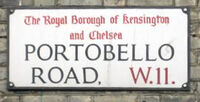| THOROUGHFARE | ||
| Portobello Road | ||
|---|---|---|

| ||
| Borough | Kensington and Chelsea | |
| District | Notting Hill North Kensington | |
| Length | - | |
| Number Range | - | |
| Type | Primarily Commercial | |
| Post Code | W11 | |
| Adjacent Streets | - | |
Portobello Road is a road in the Notting Hill district of the Royal Borough of Kensington and Chelsea in west London. It runs almost the length of Notting Hill from south to north, roughly parallel with Ladbroke Grove. On Saturdays it is home to Portobello Road Market, one of London's notable street markets, known for its second-hand clothes and antiques, and for the setting of one of the scenes in Bedknobs and Broomsticks. Every August since 1996 the Portobello Film Festival has been held in locations around Portobello Road.
History[]
Portobello Farm[]
Portobello Road was known prior to 1740 as either Green's Lane or Turnpike Lane - a winding country path leading from Kensington Gravel Pits, in what is now Notting Hill Gate, up to Kensal Green in the north.
In 1740 Portobello Farm was built in the area near what is now Golborne Road. The farm got its name from a popular victory during the War of Jenkins' Ear, when Admiral Edward Vernon captured the Spanish town of Puerto Bello (now known as Portobelo in modern-day Panama).
Green's Lane became known as Porto Bello Lane; the title which it still held in 1841.
The Portobello farming area covered the land which is now St. Charles Hospital. The farm itself was sold to an order of nuns after the railways came in 1864. They built St Joseph's Convent.
Victorian Era[]
Portobello Road is a construct of the Victorian era. Before about 1850, it was little more than a country lane connecting Portobello Farm with Kensal Green in the north and what is today Notting Hill in the south. Much of it consisted of hayfields, orchards and other open land. The road ultimately took form piecemeal in the second half of the nineteenth century, nestling between the large new residential developments of Paddington and Notting Hill. Its shops and markets thrived on serving the wealthy inhabitants of the elegant crescents and terraces that sprang up around it, and its working class residents found employment in the immediate vicinity as construction workers, domestic servants, coachmen, messengers, tradesmen and costermongers. After the Hammersmith and City Railway line was completed in 1864, and Ladbroke Grove Station opened, the northern end of Portobello Road was also developed, and the last of the open fields disappeared under brick and concrete. George Orwell lived in Portobello Road in the winter of 1927 after resigning as Assistant Superintendent of the Indian Imperial Police in Burma.[10] It should be noted that the Disney film Bedknobs and Broomsticks, although partly set in Portobello Road during one of the film's main musical numbers, is entirely filmed in a studio set which bears little or no resemblance to the real Portobello Road.
Portobello Road today[]
Portobello Road's distinctiveness does not just rely on its market. A range of communities inhabiting the street and the district contributes to a cosmopolitan and energetic atmosphere, as do the many restaurants and pubs. The architecture plays a part, too, as the road meanders and curves gracefully along most of its length, unlike the more formally planned layout of most of the nearby area. Mid- to late-Victorian terrace houses and shops predominate, squeezed tightly into the available space, adding intimacy and a pleasing scale to the streetscape. The Friends of Portobello campaign seeks to preserve the street's unique dynamic, as the potential arrival of big-brand chain stores threatens the locals.
It is the setting for Paulo Coelho's 2007 novel, The Witch of Portobello.
Geography[]
The road descends from 84 feet (25.6 m) above sea level at the northern end, the highest point, to a lowest point of 65 feet (19.8 m), just south of the overpasses, after which road rises and falls, before reaching a high point of 78 feet (23.8 m) at the southern end. The average grade of ascent or descent between the northern end and the lowest point is about 1.77 percent.
External links[]
The website is [1].
| This page uses Creative Commons Licensed content from Wikipedia (view authors). That Wikipedia page probably contains more information. |